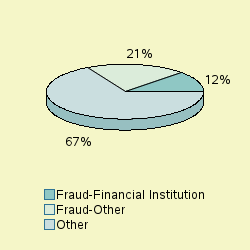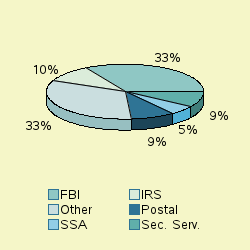
White Collar Crime Prosecutions for 2020
Number Year-to-date 4,259 Percent Change from previous year -25.3 Percent Change from 5 years ago -38.6 Percent Change from 10 years ago -56.2 Percent Change from 20 years ago -55.3
Table 1: Criminal White Collar Crime ProsecutionsThe latest available data from the Justice Department show that during FY 2020 the government reported 4,259 new white collar crime prosecutions. According to the case-by-case information analyzed by the Transactional Records Access Clearinghouse (TRAC), this number is down 25.3% over the past fiscal year when the number of prosecutions totaled 5,702.
The comparisons of the number of defendants charged with white collar crime-r offenses are based on case-by-case information obtained by TRAC under the Freedom of Information Act from the Executive Office for United States Attorneys (see Table 1).
Compared to five years ago when there were 6,935, the number of FY 2020 prosecutions of this type is down 38.6 percent. Prosecutions over the past year are lower than they were ten years ago. Overall, the data show that prosecutions of this type are down 56.2 percent from the level of 9,722 reported in 2010 and down 55.3 percent from the level of 9,532 reported in 2000.
The long term trend in white collar crime prosecutions for these matters going back to FY 2000 is shown more clearly in Figure 1. The vertical bars in Figure 1 represent the number of white collar crime prosecutions of this type recorded each fiscal year. Each presidential administration is distinguished by the color of the bars. To view trends month-by-month rather than year-by-year, see TRAC's monthly report series for the latest data.
Leading Program Categories
Within the broad category of white collar crime, cases were classified by prosecutors into more specific types.
Case types within white collar crime are
• Antitrust-Airlines
• Antitrust-Banking
• Antitrust-Defense Procurement
• Antitrust-Extraterritorial
• Antitrust-Other
• Antitrust-Other Finance Mkts.
• Fraud-Advance Fee Schemes
• Fraud-Against Ins. Provider
• Fraud-Arson for Profit
• Fraud-Bankruptcy
• Fraud-Commodities
• Fraud-Computer
• Fraud-Consumer
• Fraud-Corporate
• Fraud-Federal Procurement
• Fraud-Federal Program
• Fraud-Financial Institution
• Fraud-Health Care
• Fraud-Identity Theft-Aggravated
• Fraud-Identity Theft-Other
• Fraud-Insider Ins. Provider
• Fraud-Intellectual Property Violations
• Fraud-MEWA/MET
• Fraud-Mortgage
• Fraud-Other
• Fraud-Other Business
• Fraud-Other Insurance
• Fraud-Other Investment
• Fraud-Securities
• Fraud-Tax
• Fraud-Telemarketing
The single largest number of prosecutions of these matters through September 2020 was for "Fraud-Other", accounting for 20.6 percent of prosecutions.
As shown in Figure 2, the second largest number of matters were prosecutions filed under the program area of "Fraud-Financial Institution " (12.2%) . The "Other" category in Figure 2 is comprised of a diverse group of programs. The largest specific programs within the "Other" category were: Fraud-Health Care" (11.4%), "Fraud-Federal Program" (10.1%), "Fraud-Identity Theft-Aggravated" (8.8%), "Fraud-Tax" (8.5%), "Fraud-Other Business" (5.4%), "Fraud-Identity Theft-Other" (5.2%), "Fraud-Computer" (3.9%), "Fraud-Consumer" (2.9%), "Fraud-Securities" (2.3%). See Figure 2.
Leading Investigative Agencies
The lead investigative agency for white collar crime prosecutions through September 2020 was "Justice - Federal Bureau of Investigation" accounting for 33.3 percent of prosecutions referred.
As shown in Figure 3, additional agencies with substantial numbers of white collar crime referrals were: Treasury - Internal Revenue Service (10.2%), "Homeland Security - Secret Service (formerly Treasury)" (9.3%), "Postal Service" (9.1%), "Other - Social Security Administration" (5.2%). The "Other" category in Figure 3 is comprised of a diverse group of agencies. The agencies with substantial numbers of white collar crime within the "Other" category were: Health and Human Services" (5.1%), "Homeland Security - Other" (3.1%), "Homeland Security - Immigration an" (2.5%), "Homeland Security - Customs and B" (2.3%).
Top Ranked Lead Charges
Table 2 shows the top lead charges recorded in the prosecutions of white collar crime matters filed in U.S. District Court during FY 2020.
Note: There were an additional 247 other lead charges which were not individually ranked. See latest monthly report if you want all lead charges included in rankings for the latest month, or use TRACFED criminal analyzer tool for complete listing for any year.
Lead Charge Count Rank 1 yr ago 5 yrs ago 10 yrs ago 20 yrs ago 18 USC 1343 - Fraud by wire, radio, or television 865 1 1 1 4 6 More 18 USC 1344 - Bank Fraud 374 2 2 3 2 1 More 18 USC 1349 - Mail Fraud - Attempt and Conspiracy 366 3 3 4 6 - More 18 USC 371 - Conspiracy to commit offense or to defraud US 230 4 6 6 5 4 More 18 USC 1347 - Health Care Fraud 221 5 8 10 10 10 More 18 USC 641 - Public money, property or records 203 6 7 2 9 11 More 18 USC 1341 - Mail Fraud - Frauds and swindles 194 7 9 7 3 2 More 18 USC 1029 - Fraud and related activity - access devices 183 8 4 5 8 5 More 18 USC 1028A - Aggravated Identity Theft 153 9 5 9 1 64 More 26 USC 7206 - Fraud and False statements 149 10 11 11 11 7 More
Table 2: Top charges filed
"Fraud by wire, radio, or television" (Title 18 U.S.C Section 1343) was the most frequent recorded lead charge. Title 18 U.S.C Section 1343 was ranked 1st a year ago, while it was the 1st most frequently invoked five years ago. It was ranked 4th ten years ago and 6th twenty years ago.
Ranked 2nd in frequency was the lead charge "Bank Fraud" under Title 18 U.S.C Section 1344. Title 18 U.S.C Section 1344 was ranked 2nd a year ago, while it was the 3rd most frequently invoked five years ago. It was ranked 2nd ten years ago and 1st twenty years ago.
Ranked 3rd was "Mail Fraud - Attempt and Conspiracy" under Title 18 U.S.C Section 1349. Title 18 U.S.C Section 1349 was ranked 3rd a year ago, while it was the 4th most frequently invoked five years ago. It was ranked 6th ten years ago.
Again among the top ten lead charges, the one showing the sharpest decline in prosecutions compared to one year ago—down -50 percent—was "Aggravated Identity Theft " (Title 18 U.S.C Section 1028 ). This was the same statute that had the largest decrease—-62%—when compared with five years ago.
Top Ranked Judicial Districts
During FY 2019 the Justice Department said the government obtained 17.4 white collar crime prosecutions for every one million people in the United States. White Collar Crime prosecutions for one million people in the United States during FY 2020 were 13 . Understandably, there is great variation in the per capita number of white collar crime prosecutions in each of the nation's ninety-four federal judicial districts
Judicial District Percapita Count Rank 1yr ago 5yrs ago 10yrs ago 20yrs ago D. C. 56 39 1 4 51 4 1 More N. Y., S 43 225 2 1 1 3 2 More R. I. 42 44 3 2 64 80 80 More Mo, E 31 92 4 9 4 9 13 More La, E 31 52 5 8 5 5 9 More Okla, N 30 32 6 10 58 79 7 More Penn, W 28 105 7 14 20 46 71 More Fla, N 28 52 8 46 28 37 52 More Ga, S 25 40 9 18 16 21 75 More N. J. 24 215 10 47 59 55 47 More
Table 3: Top 10 districts (per one million people)
The District of Washington, D.C. (Washington)—with 55.52 prosecutions as compared with 13 prosecutions per one million people in the United States—was the most active through September 2020. The District of Washington, D.C. (Washington) was ranked 4th a year ago. The district's position ten years ago was 4th and 1st twenty years ago.
The Southern District of New York (Manhattan) ranked 2nd. The Southern District of New York (Manhattan) was ranked 1st a year ago as well as five years ago. The district's position ten years ago was 3rd and 2nd twenty years ago.
The District of Rhode Island now ranks 3rd. The District of Rhode Island was ranked 2nd a year ago. The district's position ten years ago was 80th as well as twenty years ago.
Recent entries to the top 10 list were Western District of Pennsylvania (Pittsburgh), Southern District of Georgia (Savannah), Northern District of Florida (Pensacola) and New Jersey, now ranked 7th, 9th, 8th and 10th. These districts ranked 14th, 18th, 46th and 47th one year ago and 20th, 16th, 28th and 59th five years ago.
Compared to 10 years ago, Southern District of Georgia (Savannah), Northern District of Florida (Pensacola), Western District of Pennsylvania (Pittsburgh), New Jersey, Northern District of Oklahoma (Tulsa) and Rhode Island now ranked in the top 10 did not appear in the top ten.
And compared to 20 years ago, Eastern District of Missouri (St. Louis), New Jersey, Northern District of Florida (Pensacola), Western District of Pennsylvania (Pittsburgh), Southern District of Georgia (Savannah) and Rhode Island were not sufficiently active to then make the top 10.
The federal judicial district which showed the greatest growth in the rate of white collar crime prosecutions compared to one year ago—73.4 percent—was Northern District of Florida (Pensacola). Compared to five years ago, the district with the largest growth—212 percent—was Washington, D.C. (Washington) .
In the last year, the judicial District Court recording the largest drop in the rate of white collar crime prosecutions—18.4 percent—was Rhode Island.
Report Generated: November 12, 2020



